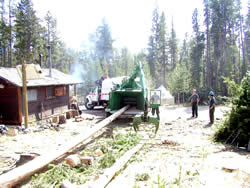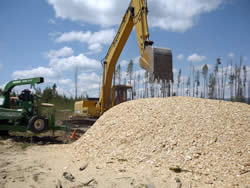
National Fire Plan Success Story
Meeting the Utilization Challenge, Chipping Fuels in Yellowstone
Yellowstone National Park, Wyoming
National Fire Plan - Fuels Reduction
2009

Yellowstone's massive chipper creates a mound of woodchips vital to the park.

Yellowstone's fire crew uses the chipper on a defensible space project.
One question facing fuels reduction programs is what is to do with the biomass produced? Traditional options include elimination through prescribed fire, or cutting, hand piling and burning. Recently, logging and other mechanical techniques have become more acceptable. Smoke-related issues and increased infrastructure development create new concerns adversely affecting land management agencies’ ability to burn. Mechanical fuels reduction will increasingly become the alternative of choice for biomass management.
The Yellowstone Fire Management Program partnered with Intermountain Regional Fire Staff and Chickasaw National Recreation Area to acquire a 20-inch capacity chipper for fuels management. The chipper was purchased with fire management funds years ago for storm damage mitigation at Chickasaw and other area units, and had completed its mission. It was then transferred to the Yellowstone equipment inventory in spring 2007, and has seen use at Grant Village, Old Faithful, and Nez Perce fuels reduction sites.
Yellowstone National Park utilizes wood chips to cover sections of road that do not hold snow due to geothermal heating. Winter transportation needs are met without bare pavement damaging vehicles or jeopardizing safety. Roads Foreman Randy Baum explained that Yellowstone last purchased chips several years ago, paying $20 for each 30 cubic yards of a 200 yard order, as well as transportation and labor costs. The park has since had difficulty acquisitioning chips. The Maintenance Division is currently utilizing chips generated by fuels reduction projects to “stretch” the supply. The Old Faithful project generated approximately 50 cubic yards of chips while the Grant project has generated about 60. Fuels reduction is projected to meet the park’s chip needs. While not a significant cost savings, it is measurable.
The chipper is dangerous and requires training to operate. The unit and operator have assisted other NPS units and the Gallatin National Forest with fuel reduction needs, making this a viable regional resource. The unit is too large and heavy to maneuver through the woods, so the greatest challenge is to get the biomass to the chipper, sometimes through a variety of winching and skidding techniques. Yellowstone managers see chipping as an integral part the fuel management program.
Contact: Andy Mitchell, Assistant Fire Management Officer, (307) 344-2182.